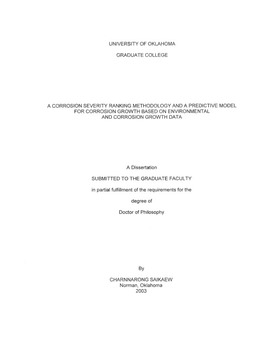| dc.contributor.advisor | Court, Mary C., | en_US |
| dc.contributor.author | Saikaew, Charnnarong. | en_US |
| dc.date.accessioned | 2013-08-16T12:19:01Z | |
| dc.date.available | 2013-08-16T12:19:01Z | |
| dc.date.issued | 2003 | en_US |
| dc.identifier.uri | https://hdl.handle.net/11244/624 | |
| dc.description.abstract | This dissertation presents a new methodology for defining corrosion severity ranking by location for six operational air force bases, Hickam Air Force Base (AFB), Kadena Air Base (AB), Macdill AFB, Royal Air Force (RAF) Mildenhall, Pease Air National Guard Base (ANGB), and Seymour Johnson AFB. Three new corrosion growth predictive models are also presented so that a foundation for establishing a corrosion maintenance and inspection schedule of the C/KC-135 aircraft can be developed. The corrosion severity ranking scheme and the predictive growth models for the six operational air force bases will allow the United States Air Force (USAF) to concentrate their efforts on proactively inspecting aircraft for corrosion when deployed and operated at bases deemed as highly severe corrosion sites. | en_US |
| dc.description.abstract | The method of principal component analysis (PCA) is used for the first time to analyze compositional data sets of atmospheric conditions (or thresholds) for defining corrosion severity ranking by locations (air force bases). The results show that the ranking for the six operational air bases from the most severe site to the least severe site is Hickam AFB, Kadena AB, Macdill AFB, Seymour Johnson AFB, RAF Mildenhall, and Pease ANGB. | en_US |
| dc.description.abstract | In order to develop a more accurate corrosion growth predictive model, three corrosion growth predictive models are developed by modifying and combining the following existing growth models: the Gompertz growth and the logistic growth models (GL model), the Gompertz growth and the confined exponential growth models (GC model), and the logistic growth and the confined exponential growth models (CL model). The confined exponential growth model, the power law equation, and the three new models (i.e., GL, GC, and CL models) are compared through lack-of-fit tests and model adequacy checking (after performing weighted least square analysis). Corrosion growth data sets from four operational air bases (Hickam AFB, Kadena AB, RAF Mildenhall, and Seymour Johnson AFB) are used to perform the statistical tests. The results showed that the CL model provides the best fit for all corrosion growth data sets of the four operational air bases and dominates the other models in terms of weighted mean square error. The CL model also reveals that Hickam AFB is the most severe corrosion site and supports the results of the PCA analysis on corrosion severity ranking. Although other corrosion growth models exist, this research represents the first models based on corrosion growth data of alloys obtained from operational C/KC-135 aircraft. | en_US |
| dc.format.extent | xiii, 172 leaves : | en_US |
| dc.subject | Airframes. | en_US |
| dc.subject | Aluminum Corrosion. | en_US |
| dc.subject | Engineering, Industrial. | en_US |
| dc.subject | KC-135 (Tanker aircraft) | en_US |
| dc.subject | Airplanes Maintenance and repair. | en_US |
| dc.title | A corrosion severity ranking methodology and a predictive model for corrosion growth based on environmental and corrosion growth data. | en_US |
| dc.type | Thesis | en_US |
| dc.thesis.degree | Ph.D. | en_US |
| dc.thesis.degreeDiscipline | School of Industrial and Systems Engineering | en_US |
| dc.note | Source: Dissertation Abstracts International, Volume: 64-06, Section: B, page: 2861. | en_US |
| dc.note | Major Professor: Mary C. Court. | en_US |
| ou.identifier | (UMI)AAI3094295 | en_US |
| ou.group | College of Engineering::School of Industrial and Systems Engineering | |
